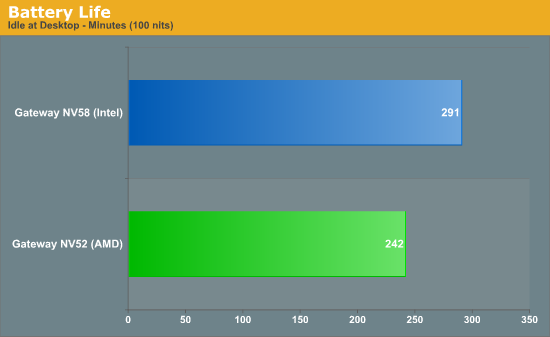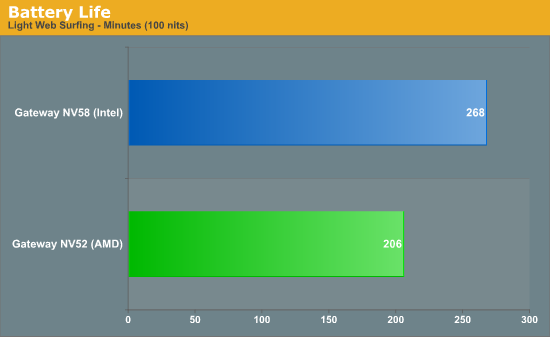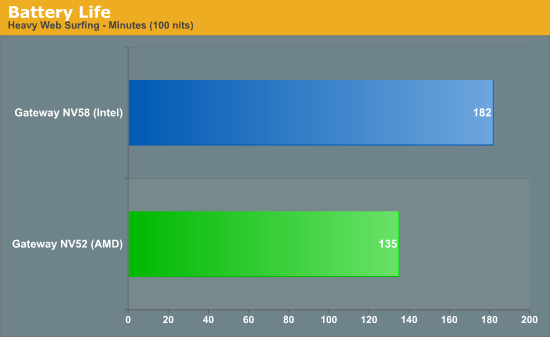AMD vs. Intel: Battery Life Investigated
by Jarred Walton on August 5, 2009 5:00 PM EST- Posted in
- Laptops
AMD vs. Intel: Battery Life Investigated
Both laptops used identical power saving settings under Windows Vista's "Balanced" plan (with some minor tweaks to the defaults on both systems). We ran five different test scenarios, ranging from best-case idle battery life at the Windows desktop to a far more taxing DVD/x264 playback results, along with two different Internet surfing benchmarks. One Internet benchmark represents a "light" load while the other has far more Flash content and represents a "heavy" load. We set both LCDs to 100 nits brightness (40% in this case) and completed a couple charge/discharge cycles to break in the battery before beginning our tests. Here are the results.





Considering these systems are as close as we can get to "identical", AMD takes a real pounding in battery life testing. The closest result (the idle test) has the Intel platform providing 20% more battery life, while the best Intel results (DVD playback and heavy web surfing) give about 35% more battery life. Averaging all five results, the Intel-based NV58 delivered 28% more battery life than the AMD-based NV52. Ouch.
Obviously, despite having identical clock speeds there are some real differences between the two processors. For one, Intel's T6500 is a 45nm part compared to the 65nm QL-64 (not that AMD has 45nm parts yet). We also don't know how much of an impact the various chipset and motherboard components might have. What we do know is that AMD's current mobile processor lineup consists of dual-core CPUs that range from 2.00GHz up to 2.50GHz, with most having a 31W TDP to 35W TDP rating; the TK-42 is a 20W 1.60GHz part and the QL-62 is a 25W 2.00GHz part. Intel on the other hand has many more options. 10W dual-core CPUs are available with clock speeds of 1.06GHz to 1.60GHz; 17W chips have clock speeds ranging from 1.33GHz to 2.13GHz; 25W processors start at 2.26GHz and end at 2.66GHz; and the 34/35W parts cover the gamut from 1.60GHz all the way up to 3.06GHz… and that's just the Core 2 Duo parts! Pentium Dual-Core, Core 2 Quad, and Core 2 Extreme parts are also available to flesh out the spectrum. Then again, some of those parts cost twice as much as the Gateway NV52 just for the CPU.
When Intel released Banias and the Centrino platform in March 2003, they started a revolution in their approach to mobile processor design. Power and efficiency became the focus rather than pure clock speed, and the result has been much better mobile processors when it comes to performance per Watt. Unfortunately for AMD, they appear stuck with the old way of doing things: build a generic architecture and then optimize it for power requirements on mobile chips. Essentially the same core K8 architecture that launched in 2003 continues to power AMD's mobile offerings, and while the ensuing shrink to 65nm has helped there's still a lot of ground to make up. AMD-based laptops are still more than fast enough for most users -- and let's make this clear, a $500 dual-core AMD laptop is tons faster than anything using Intel Atom (though it uses more power, obviously) -- but Intel has the upper hand. It's unfortunate there's not more competition in the mobile processor space, or we might start really start to see prices drop!
For now, if you're looking for an inexpensive laptop (not a netbook), you need reasonable battery life, and you don't care about graphics performance we suggest saving up the extra $50-$100 for an Intel-based system.










80 Comments
View All Comments
medi01 - Monday, August 10, 2009 - link
GPU is a couple of hundred percent faster.CPU is a couple of dozen percent faster.
Many people I know actually play games on their laptops.
JarredWalton - Monday, August 10, 2009 - link
It's about 100% faster on average... and tell me this: what's twice as fast as horribly slow? The fact is, even the ATI 780G HD 3200 IGP struggles mightily in most modern 3D titles. Far Cry 2, absolute minimum detail settings, gets 24FPS at 800x600 (or 16FPS at the native 1366x768). Assassin's Creed, minimum settings are the same (24FPS/15FPS at 800x600/1366x768). Need I mention that both of those games look like garbage at the minimum settings? Mass Effect: 11FPS at 800x600 (unplayable), and Riddick: Dark Athena is about the same (12.6FPS at 800x600).If you were to go out and purchase a laptop with a GeForce 9500M or Radeon HD 3650 level GPU, you'd be about three to four times as fast as the HD 3200. Then you can actually play games if you'd like, though you'll also have lower battery life. Considering about 90% of laptop users probably never do anything gaming related outside of Solitaire, I'd say they'd be far more interested in the $580 Intel system that is noticeably faster (30%) in many tasks and ALSO provides 30% more battery life.
MikosNZ - Thursday, August 6, 2009 - link
I hate to state the obvious but I see no mention of battery testing or the same battery being used for both laptops in these tests. Lithium ion batteries are notorious for large variances in electrical capacity due to both shelf life and batch. This could easily account for 20-30% PLUS variance. I have seen numbers easily around that when doing battery testing for commercial laptops. These tests are completely worthless unless the same battery was swapped between the two or the batteries used were separately tested to ensure equivalence. I would definitely not rely on gateway to QA their batteries to a level required for accurate platform testing.MikosNZ - Thursday, August 6, 2009 - link
Actually on second read there does seem to be some implicit references to this. Was this actually done after all?JarredWalton - Thursday, August 6, 2009 - link
Nope, but if it will make you feel better I'll swap batteries between the two and rerun one of the tests to check results. I'd wager less than a 2% difference but I could be wrong.... Check back tomorrow.JarredWalton - Thursday, August 6, 2009 - link
Swapping the batteries, the results stay essentially the same in the Idle battery test. With the original batteries, the Intel system has 20.25% more battery life. Switching the result was 19.57% better battery life.FWIW, both systems scored slightly lower after the battery swap - 230 vs. 242 on the AMD and 275 vs. 291 on the Intel system. All settings remained the same, but I started the tests right after the batteries hit 100% charge coming back up from 88% (they were sleeping and unplugged much of yesterday). If necessary, I can fully charge them and rerun the test, but a margin of error of around 2-3% is normal in battery tests when you don't short the discharge/charge cycle, and not fully discharging a battery will frequently result in less battery life on the next cycle.
lyeoh - Friday, August 7, 2009 - link
Thanks for doing that.While the result was not surprising, it was good to eliminate that.
Different batches of batteries have been known to perform differently (some even explosively ;) ).
It might be the AMD laptop's graphics system that's the power hog.
But whatever it is, it doesn't look good for AMD.
FWIW, some Macbooks seem to have rather good battery life, I wonder if they do any special tricks that the windows laptops don't.
JarredWalton - Friday, August 7, 2009 - link
They say MacBooks do some power saving "tricks" that don't use the standard ACPI interface or something. They also have better control over the OS/hardware, and OS X looks like it manages to stay in low-power C-states much better than any Windows OS.Jeffk464 - Thursday, August 6, 2009 - link
Is amd coming up with anything to compete with Intels new Ultra low voltage cpu. I'm thinking about going this route for my next laptop, coupled with led backlight display these systems are getting unreal batter life. Check out the acer timeline series, the only thing is there kind of slow getting the core 2 duo out.Zagor Tenay - Wednesday, August 5, 2009 - link
Battery life should not be a concern at all for most laptop users, because most people use their laptops at home. Their laptops are treated like a desktop, power cable attached at all times. (They say they prefer a laptop because it uses less space, there is no cable clutter etc.) So, what is the point in paying a higher price premium for an Intel laptop, because it has a longer battery life? The answer is plain and simple: There is no reason.